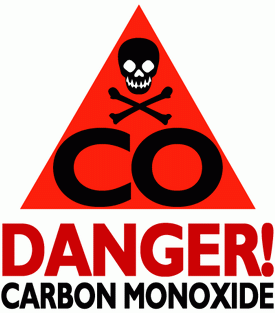
Carbon monoxide (CO), a byproduct of internal combustion engines, is an invisible, odorless, tasteless gas. CO can make you sick in seconds. In high enough concentrations, even a few breaths can be fatal. Sources of CO on your vessel may include engines, gas generators, cooking ranges and space and water heaters. A good precaution is to keep air moving through the boat.
• Early symptoms of CO poisoning include irritated eyes, headache, nausea, weakness and dizziness. Symptoms are often confused with seasickness or intoxication. Get anyone with these symptoms into fresh air immediately.
Seek medical attention unless you’re sure it’s not CO poisoning.
• Protect yourself and others by keeping fresh air flowing through and around the vessel, know where your engine exhaust outlets are, and keep everyone away from them. This is especially important on houseboats, where people often gather to rest after swimming.
• Boaters are encouraged to install a CO detector.
If your boat is equipped with a swim platform, turn off all engines with transom exhaust ports, while it is in use or if people are swimming behind the boat, and advise swimmers never to go under the platform. Never pull people who are holding onto swim platforms. This is called teak surfing and is against the law in Oregon. Carbon monoxide can collect in enclosed spaces such as under swim platforms and in cabins.
Ventilation (Fuel Vapors)
Any boat using a fuel with a flashpoint of 110° or less (gasoline but not diesel) that has any enclosed engine or fuel tanks spaces (not open to the atmosphere) , must have an efficient ventilation system to disperse explosive gases.
Natural ventilation consists of at least two ventilation ducts fitted with cowls or their equivalent. At least one exhaust duct extending to the lower portion of the bilge and at least one intake (supply) duct extending to a point midway to the bilge or at least below the level of the carburetor air intake is required.
Boats built after July 31, 1980 are required to have powered ventilation (exhaust blower) for engine compartments that are not open to the atmosphere. Such boats are required to display a warning label such as this:
“Warning -gasoline vapors can explode. Before starting engine operate blower for four minutes and check engine compartment bilge for gasoline vapors. Gas vapors contained in an enclosed space make a boat a potential bomb waiting to go off!”
NOTE: Check the galley! Butane and propane are even more dangerous than gasoline. Heavier than air, they flow rapidly into the lower part of the boat and are extremely difficult to remove. If you cook with a liquid petroleum gas such as propane or butane, be sure the fuel tank enclosure is properly ventilated.